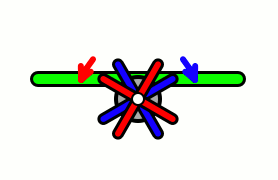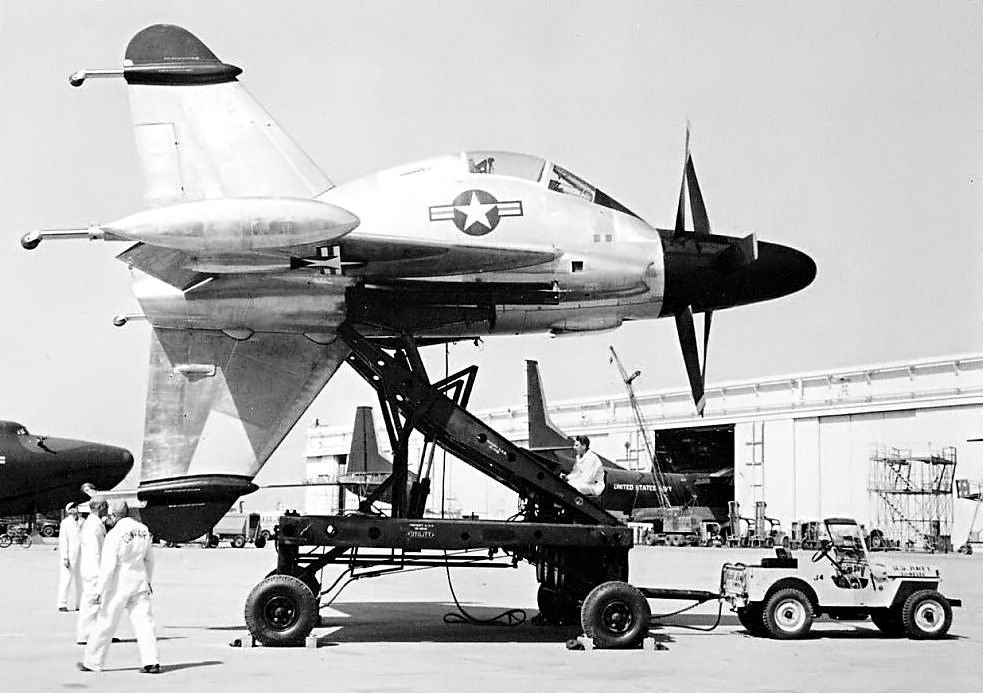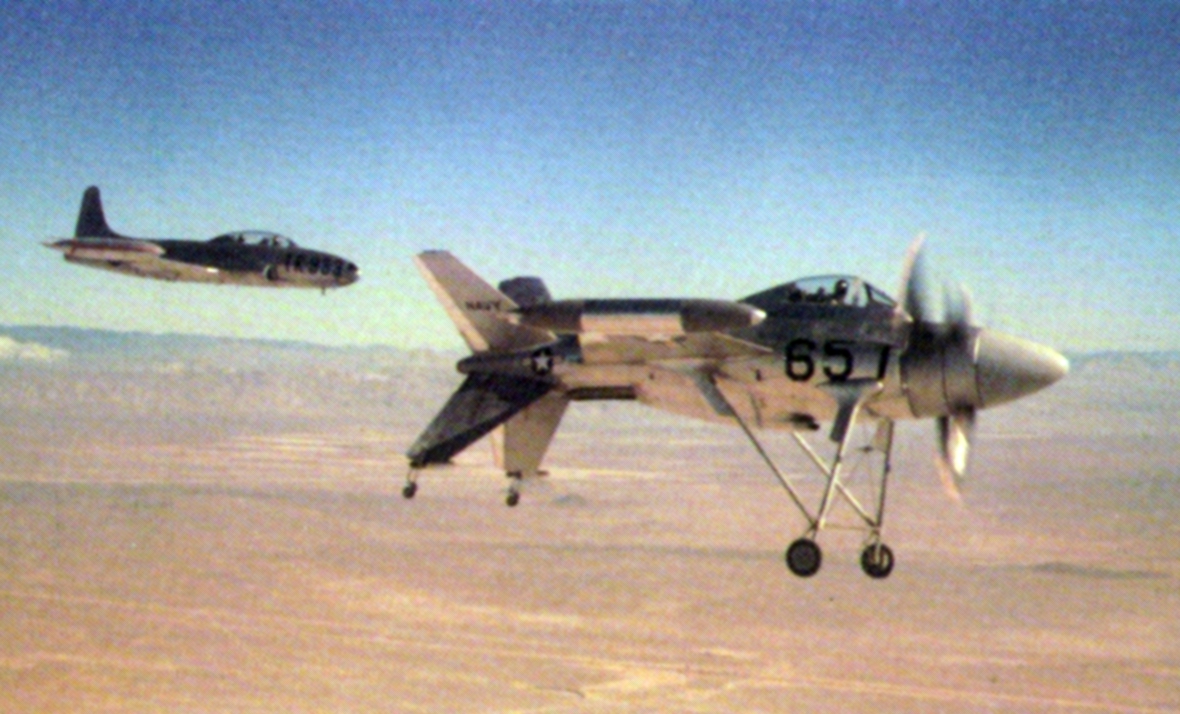|
Contra-rotating
Contra-rotating, also referred to as coaxial contra-rotating, is a technique whereby parts of a mechanism rotate in opposite directions about a common axis, usually to minimise the effect of torque. Examples include some aircraft propellers, resulting in the maximum power of a single piston or turboprop engine to drive two propellers in opposite rotation. Contra-rotating propellers are also common in some marine transmission systems, in particular for large speed boats with planing hulls. Two propellers are arranged one behind the other, and power is transferred from the engine via planetary gear transmission. The configuration can also be used in helicopter designs termed coaxial rotors, where similar issues and principles of torque apply. Contra-rotating propellers should not be confused with counter-rotating propellers, a term which describes propellers rotating in opposite directions but sitting apart from each other on separate shafts instead of sharing a common axis. T ... [...More Info...] [...Related Items...] OR: [Wikipedia] [Google] [Baidu] |
Contra-rotating Propellers
Aircraft equipped with contra-rotating propellers (CRP) coaxial contra-rotating propellers, or high-speed propellers, apply the maximum power of usually a single engine piston powered or turboprop engine to drive a pair of coaxial propellers in contra-rotation. Two propellers are arranged one behind the other, and power is transferred from the engine via a planetary gear or spur gear transmission. Although contra-rotating propellers are also known as '' counter-rotating propellers'', the term is much more widely used when referring to airscrews on separate non-coaxial shafts turning in opposite directions. Operation When airspeed is low, the mass of the air flowing through the propeller disk (thrust) causes a significant amount of tangential or rotational air flow to be created by the spinning blades. The energy of this tangential air flow is wasted in a single-propeller design, and causes handling problems at low speed as the air strikes the vertical stabilizer, causing the ... [...More Info...] [...Related Items...] OR: [Wikipedia] [Google] [Baidu] |
Contra-rotating Marine Propellers
Contra-rotating propellers have benefits when providing thrust in marine applications. Contra-rotating propellers are used on torpedoes due to the natural torque compensation and are also used in some motor boats. The cost of boring out the outer shafts and problems of mounting the inner shaft bearings are not worth pursuing in case of normal ships. Advantages and disadvantages Advantages *The propeller-induced Sailing#Heeling, heeling moment is compensated (negligible for larger ships). *More power can be transmitted for a given propeller radius. *The propeller efficiency is increased by recovering energy from the tangential (rotational) flow from the leading propeller. Tangential flow does not contribute to thrust, conversion of tangential to axial flow increases both thrust and overall system efficiency. Disadvantages *The mechanical installation of coaxial contra-rotating shafts is complicated and expensive and requires more maintenance. *The hydrodynamic gains are partiall ... [...More Info...] [...Related Items...] OR: [Wikipedia] [Google] [Baidu] |
Torpedo
A modern torpedo is an underwater ranged weapon launched above or below the water surface, self-propelled towards a target, with an explosive warhead designed to detonate either on contact with or in proximity to the target. Historically, such a device was called an automotive, automobile, locomotive, or fish torpedo; colloquially, a ''fish''. The term ''torpedo'' originally applied to a variety of devices, most of which would today be called mines. From about 1900, ''torpedo'' has been used strictly to designate a self-propelled underwater explosive device. While the 19th-century battleship had evolved primarily with a view to engagements between armored warships with large-caliber guns, the invention and refinement of torpedoes from the 1860s onwards allowed small torpedo boats and other lighter surface vessels, submarines/submersibles, even improvised fishing boats or frogmen, and later light aircraft, to destroy large ships without the need of large guns, though somet ... [...More Info...] [...Related Items...] OR: [Wikipedia] [Google] [Baidu] |
Convair XFY
The Convair XFY-1 Pogo is an experimental V/STOL (vertical/short takeoff and landing) aircraft developed during the early years of the Cold War. It was intended to be a high-performance fighter aircraft capable of operating from small warships. Lockheed and Convair were awarded contracts to build experimental VTOL fighters, with Convair producing the XFY-1, also known as the "Pogo." It was developed as an attempt to create a practical V/STOL aircraft. The XFY-1 featured a unique design with delta wings and three-bladed contra-rotating propellers powered by a turboprop engine. Test flights began in 1954, and the aircraft's capabilities were pushed to their limits. Challenges included difficulties in slowing down and landing at high speeds, as well as the need for highly skilled pilots due to its complex handling characteristics. Landing the XFY-1 was difficult, as the pilot had to look over his shoulder while carefully working the throttle to land. Ultimately, technical and oper ... [...More Info...] [...Related Items...] OR: [Wikipedia] [Google] [Baidu] |
Lockheed XFV
The Lockheed XFV (sometimes referred to as the "Salmon") is an American Experimental aircraft, experimental tailsitter prototype aircraft built by Lockheed Corporation, Lockheed in the early 1950s to demonstrate the operation of a VTOL, vertical takeoff and landing (VTOL) fighter for protecting convoys. Design and development The Lockheed XFV originated as a result of a proposal issued by the U.S. Navy in 1948 for an aircraft capable of vertical takeoff and landing (VTOL) aboard platforms mounted on the afterdecks of conventional ships. Both Convair and Lockheed competed for the contract but in 1950, the requirement was revised, with a call for a research aircraft capable of eventually evolving into a VTOL ship-based convoy escort fighter. On 19 April 1951, two prototypes were ordered from Lockheed under the designation XFO-1 (company designation was Model 081-40-01). Soon after the contract was awarded, the project designation changed to XFV-1 when the 1922 United States Navy ... [...More Info...] [...Related Items...] OR: [Wikipedia] [Google] [Baidu] |
Turboprop
A turboprop is a Gas turbine, gas turbine engine that drives an aircraft Propeller (aeronautics), propeller. A turboprop consists of an intake, reduction drive, reduction gearbox, gas compressor, compressor, combustor, turbine, and a propelling nozzle. Air enters the intake and is compressed by the compressor. Fuel is then added to the compressed air in the combustor, where the Fuel mixture, fuel-air mixture then Combustion, combusts. The hot combustion gases expand through the turbine stages, generating power at the point of exhaust. Some of the power generated by the turbine is used to drive the compressor and electric generator. The gases are then exhausted from the turbine. In contrast to a turbojet or turbofan, the engine's exhaust gases do not provide enough power to create significant thrust, since almost all of the engine's power is used to drive the propeller. Technological aspects Exhaust thrust in a turboprop is sacrificed in favor of shaft power, which is obtaine ... [...More Info...] [...Related Items...] OR: [Wikipedia] [Google] [Baidu] |
Helicopter
A helicopter is a type of rotorcraft in which Lift (force), lift and thrust are supplied by horizontally spinning Helicopter rotor, rotors. This allows the helicopter to VTOL, take off and land vertically, to hover (helicopter), hover, and to fly forward, backward and laterally. These attributes allow helicopters to be used in congested or isolated areas where fixed-wing aircraft and many forms of short take-off and landing (STOL) or short take-off and vertical landing (STOVL) aircraft cannot perform without a runway. The Focke-Wulf Fw 61 was the first successful, practical, and fully controllable helicopter in 1936, while in 1942, the Sikorsky R-4 became the first helicopter to reach full-scale mass production, production. Starting in 1939 and through 1943, Igor Sikorsky worked on the development of the Vought-Sikorsky VS-300, VS-300, which over four iterations, became the basis for modern helicopters with a single main rotor and a single tail rotor. Although most earlier ... [...More Info...] [...Related Items...] OR: [Wikipedia] [Google] [Baidu] |
H-43 Huskie
The Kaman HH-43 Huskie is a helicopter developed and produced by the American rotorcraft manufacturer Kaman Aircraft. It is perhaps most distinctive for its use of twin intermeshing rotors, having been largely designed by the German aeronautical engineer Anton Flettner. First flown on 21 April 1953, the HH-43 went into production and was operated by several military air services, including the United States Air Force, the United States Navy and the United States Marine Corps. It was primarily intended for use in aircraft firefighting and rescue in the close vicinity of air bases, but was extensively deployed during the Vietnam War. It was used as a search and rescue platform, having often been enhanced with makeshift modification and new apparatus to better suit the tropical conditions. The HH-43 was also exported to several other countries and sold commercially. It set several aviation records in its class, and was the first helicopter to experiment with twin-turbine engines. Th ... [...More Info...] [...Related Items...] OR: [Wikipedia] [Google] [Baidu] |
Coaxial Rotors
A coaxial-rotor aircraft is an aircraft whose helicopter rotor, rotors are mounted one above the other on Concentric objects, concentric shafts, with the same axis of rotation, but turning in opposite directions (contra-rotating). This rotor configuration is a feature of helicopters produced by the Russian Kamov helicopter design bureau. History The idea of coaxial rotors originates with Mikhail Lomonosov. He had developed a small helicopter model with coaxial rotors in July 1754 and demonstrated it to the Russian Academy of Sciences. In 1859, the British Patent Office awarded the first helicopter patent to Henry Bright for his coaxial design. From this point, coaxial helicopters developed into fully operational machines as we know them today. Two pioneering helicopters, the Corradino D'Ascanio#Between the wars, Corradino D'Ascanio-built "D'AT3" of 1930, and the generally more successful French mid-1930s ''Gyroplane Laboratoire'', both used coaxial rotor systems for flight. ... [...More Info...] [...Related Items...] OR: [Wikipedia] [Google] [Baidu] |
Counter-rotating Propellers
Counter-rotating propellers (CRP) are propellers which turn in opposite directions to each other. They are used on some twin- and multi-engine propeller-driven aircraft. The propellers on most conventional twin-engined aircraft turn clockwise (as viewed from behind the engine). Counter-rotating propellers generally turn clockwise on the left engine and counterclockwise on the right. The advantage of such designs is that counter-rotating propellers balance the effects of torque and P-factor, meaning that such aircraft do not have a critical engine in the case of engine failure. Drawbacks of counter-rotating propellers come from the fact that, in order to reverse the rotation of one propeller, either one propeller must have an additional reversing gearbox, or the engines themselves must be adapted to turn in opposite directions. (Meaning that there are essentially two engine designs, one with left-turning and the other with right-turning parts, which complicates manufacture a ... [...More Info...] [...Related Items...] OR: [Wikipedia] [Google] [Baidu] |
Jet Engine
A jet engine is a type of reaction engine, discharging a fast-moving jet (fluid), jet of heated gas (usually air) that generates thrust by jet propulsion. While this broad definition may include Rocket engine, rocket, Pump-jet, water jet, and hybrid propulsion, the term typically refers to an internal combustion airbreathing jet engine, air-breathing jet engine such as a turbojet, turbofan, ramjet, pulse jet engine, pulse jet, or scramjet. In general, jet engines are internal combustion engines. Air-breathing jet engines typically feature a Axial compressor, rotating air compressor powered by a turbine, with the leftover power providing thrust through the propelling nozzle—this process is known as the Brayton cycle, Brayton thermodynamic cycle. Jet aircraft use such engines for long-distance travel. Early jet aircraft used turbojet engines that were relatively inefficient for subsonic flight. Most modern subsonic jet aircraft use more complex High-bypass turbofan, high-bypas ... [...More Info...] [...Related Items...] OR: [Wikipedia] [Google] [Baidu] |
F-35 Lightning II
The Lockheed Martin F-35 Lightning II is an American family of single-seat, single-engine, supersonic Stealth aircraft, stealth strike fighters. A multirole combat aircraft designed for both Air superiority fighter, air superiority and attack aircraft, strike missions, it also has electronic warfare and intelligence, surveillance, and reconnaissance capabilities. Lockheed Martin is the prime F-35 contractor with principal partners Northrop Grumman and BAE Systems. The aircraft has three main variants: the CTOL, conventional takeoff and landing (CTOL) F-35A, the STOVL, short take-off and vertical-landing (STOVL) F-35B, and the carrier-based, carrier variant (CV) Catapult Assisted Take-Off But Arrested Recovery, catapult-assisted take-off but arrested recovery (CATOBAR) F-35C. The aircraft descends from the Lockheed Martin X-35, which in 2001 beat the Boeing X-32 to win the Joint Strike Fighter program, Joint Strike Fighter (JSF) program intended to replace the General Dynami ... [...More Info...] [...Related Items...] OR: [Wikipedia] [Google] [Baidu] |









